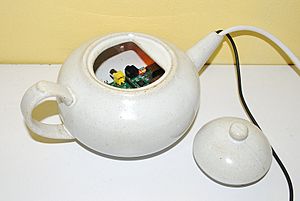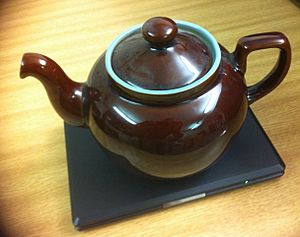Hyper Text Coffee Pot Control Protocol facts for kids

The "back-end" system of error418.net, which uses HTCPCP
|
|
| International standard | Internet Engineering Task Force |
|---|---|
| Developed by | Larry Masinter |
| Introduced | April 1, 1998 |
The Hyper Text Coffee Pot Control Protocol (HTCPCP) is a funny internet rule for controlling and checking on coffee pots. It was created as an April Fools' Day joke on April 1, 1998. This protocol was described in a document called RFC 2324.
Later, on April 1, 2014, an update called HTCPCP-TEA was released. This new version, RFC 7168, added support for making tea. It was also an April Fools' Day joke!
Contents
What is HTCPCP?
 RFC 2324 was written by Larry Masinter. He said it was a joke with a serious point. It showed how the main internet rule, HTTP, was sometimes used in ways it wasn't meant for. The document itself made it clear it wasn't serious. For example, it joked that there was a "strong, dark, rich requirement" for a rule just for making coffee.
RFC 2324 was written by Larry Masinter. He said it was a joke with a serious point. It showed how the main internet rule, HTTP, was sometimes used in ways it wasn't meant for. The document itself made it clear it wasn't serious. For example, it joked that there was a "strong, dark, rich requirement" for a rule just for making coffee.
Even though it started as a joke, HTCPCP has stayed a small part of the internet world. The computer program Emacs has a working version of it. Also, people have reported "bugs" because the web browser Mozilla doesn't support it. Ten years after HTCPCP came out, a group called the Web-Controlled Coffee Consortium (WC3) even made a joke document about it. This document made fun of how the real World Wide Web Consortium (W3C) describes internet rules.
On April 1, 2014, RFC 7168 was released. This update allowed HTCPCP to work with teapots too.
Commands and Responses
HTCPCP is an extension of HTTP, which is the main rule for how web pages work. HTCPCP requests start with the word coffee. They also add some new commands to the usual HTTP ones:
- BREW or POST: This command tells the coffee pot server to make coffee. Using POST for this is not the best way anymore. A new request part called "Accept-Additions" was suggested. This lets you ask for things like Cream, Whole-milk, Vanilla, Raspberry, or Whisky in your coffee.
- GET: This command "gets" coffee from the HTCPCP server.
- PROPFIND: This command gives you information about the coffee.
- WHEN: This command is like saying "when" to stop pouring. It tells the HTCPCP server to stop adding milk to the coffee.
The protocol also has two special error messages:
- 406 Not Acceptable: This means the HTCPCP server cannot give you the extra ingredient you asked for. The message should list what additions are available. The document notes that most automatic coffee pots can't add things anyway.
- 418 I'm a teapot: This means the HTCPCP server is actually a teapot! The message might even say "may be short and stout," which is a funny reference to the song "I'm a Little Teapot". You can find examples online where this error message appears.
The Save 418 Movement
On August 5, 2017, Mark Nottingham, who leads a group at the IETF, suggested removing the "418 I'm a teapot" error code. He wanted it removed from popular computer platforms like Node.js, Go, Python, and ASP.NET.
In response, a 15-year-old developer named Shane Brunswick created a website called save418.com. He started the "Save 418 Movement." He argued that the "418 I'm a teapot" code reminds us that computer processes are still made by humans. His website quickly became very popular. It got thousands of upvotes on Reddit and led to the "#save418" trend on Twitter.
Because of this public support, Node.js, Go, Python, and ASP.NET decided not to remove the "418 I'm a teapot" code. This strong support from both projects and the public led Mark Nottingham to make "418" a special, reserved HTTP status code. This means it won't be replaced by another official code in the future.
On October 5, 2020, Python 3.9 was released. It included the "418 IM_A_TEAPOT" status code. The "Save 418 Movement" was directly mentioned as a reason for including it.
How it's Used
Around the time of the 2021-2022 Russo-Ukrainian crisis, the Russian military website mil.ru sometimes showed the HTTP 418 status code. This happened when people tried to access it from outside Russia. It was a way to protect the site from too much traffic, like a DDoS attack. This change was first noticed in December 2021.
Images for kids
See also
In Spanish: Hyper Text Coffee Pot Control Protocol para niños




